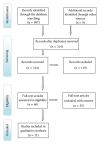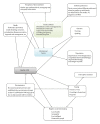A systematic review of individual motivational factors in orthodontic treatment: facial attractiveness as the main motivational factor in orthodontic treatment
- PMID: 24963296
- PMCID: PMC4055094
- DOI: 10.1155/2014/938274
A systematic review of individual motivational factors in orthodontic treatment: facial attractiveness as the main motivational factor in orthodontic treatment
Abstract
Introduction. Physical, mental, and social consequences of malocclusion may impact the quality of life. The aim of this review is to describe main factors motivating parents for orthodontic treatment for their children. Methods. A systematic review study design was used to identify articles analyzing different motivational factors in orthodontic treatment appearing in Medline database, EMBASE, and Google Scholar. The search terms used were teasing, motivating factors, orthodontics, malocclusion, quality of life, smile attractiveness, and perception of malocclusion. Papers selected up to May 2013 included retrospective and prospective longitudinal studies, randomized control trials, cross-sectional studies, reviews, and meta-analyses. Results. 13 articles included in this review identified aesthetics as the main motivational factor in orthodontic treatment. Children mention teeth crowding, large overbite, missing teeth, and largest maxillary anterior irregularities also as motivational factors. Parents want their children to look nice and worry of being accused of neglecting parental duties. Conclusions. Dissatisfaction with one's appearance, dentist recommendation, interest and worries of parents, and the impact of peers who wear braces rank among the main motivation factors of seeking orthodontic treatment. Understanding these factors allows better planning of resources and better assessment of the requirements and priorities of treatment.
Figures
References
-
- Ong E, Brown RA, Richmond S. Peer assessment of dental attractiveness. American Journal of Orthodontics and Dentofacial Orthopedics. 2006;130(2):163–169. - PubMed
-
- Honn M, Goz G. The ideal of facial beauty: a review. Journal of Orofacial Orthopedics. 2007;68(1):6–16. - PubMed
-
- Tung AW, Kiyak HA. Psychological influences on the timing of orthodontic treatment. American Journal of Orthodontics and Dentofacial Orthopedics. 1998;113(1):29–39. - PubMed
-
- Helm S, Kreiborg S, Solow B. Psychosocial implications of malocclusion: a 15-year follow-up study in 30-year-old Danes. American Journal of Orthodontics. 1985;87(2):110–118. - PubMed
-
- Nanda RS, Ghosh J. Facial soft tissue harmony and growthin orthodontic treatment. Seminars in Orthodontics. 1995;1(2):67–81. - PubMed
Publication types
LinkOut - more resources
Full Text Sources
Other Literature Sources



